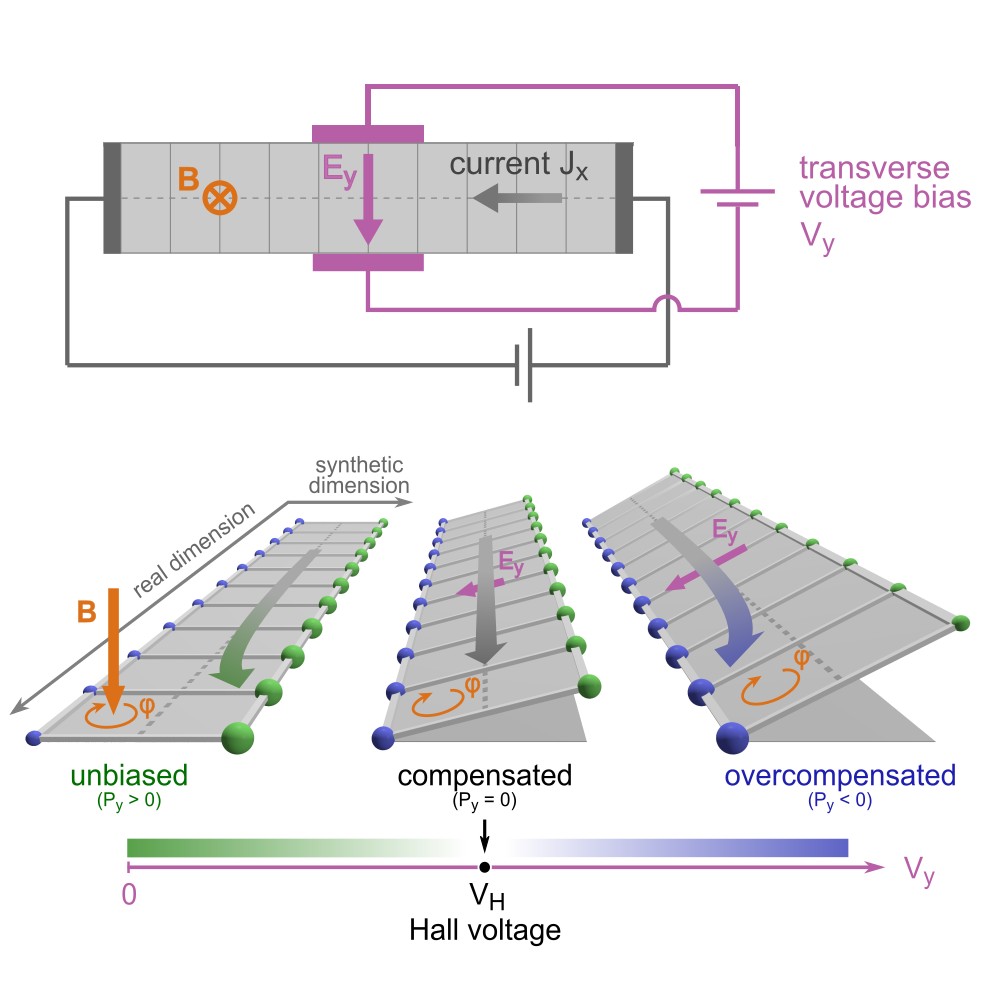 |
The Hall effect is a cornerstone of modern science, spanning applications from cutting-edge technologies to the discovery of exotic topological phases of matter. In solid-state systems, it manifests as a voltage perpendicular to current flow in a magnetic field, giving rise to transverse Hall resistance. Yet, its behavior in quantum systems remains elusive. Using neutral-atom quantum simulators, we introduce the first direct measurement of Hall voltage and resistance in a non-electron-based system. This work links quantum simulations to real-world experiments, unlocking new avenues to explore the Hall effect in tunable, strongly correlated systems. T.-W. Zhou et al. |
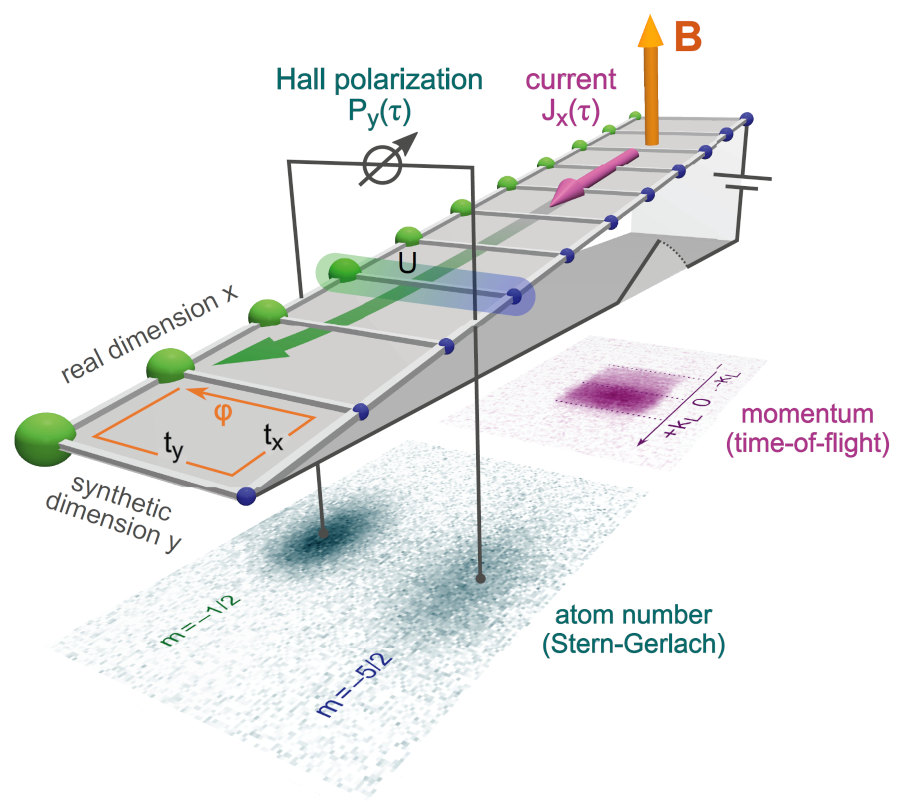 |
The Hall effect, which originates from the motion of charged particles in magnetic fields, has deep consequences for the description of materials, extending far beyond condensed matter. Understanding such an effect in interacting systems represents a fundamental challenge, even for small magnetic fields. In this work, we used an atomic quantum simulator in which we tracked the motion of ultracold fermions in two-leg ribbons threaded by artificial magnetic fields. Through controllable quench dynamics, we measured the Hall response for a range of synthetic tunneling and atomic interaction strengths. We unveil a universal interaction-independent behavior above an interaction threshold, in agreement with theoretical analyses. The ability to reach hard-to-compute regimes demonstrates the power of quantum simulation to describe strongly correlated topological states of matter. T.-W. Zhou et al. |
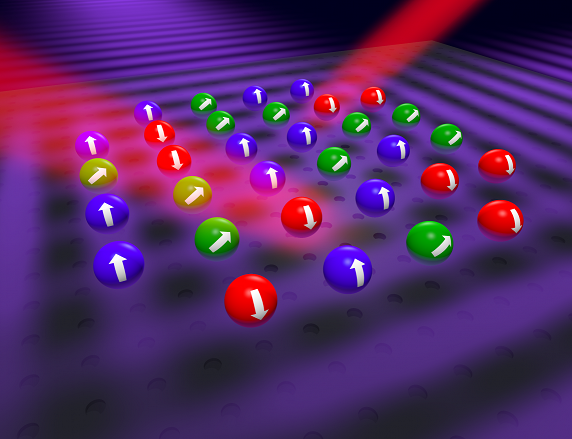 |
A large repulsion between particles in a quantum system can lead to their localization, an effect responsible for the Mott insulator phases in strongly correlated materials. In a system with multiple orbitals, an orbital-selective Mott insulator can form, where electrons in some orbitals are predicted to localize while others remain itinerant. Here we demonstrate a more general version of this phenomenon by observing flavour-selective localization in an atom-based quantum simulator. Our experiment realizes Fermi–Hubbard models with an SU(3) symmetry that can be broken using a tunable coupling between flavours. We observe an enhancement of the localization associated with a selective Mott transition and the emergence of flavour-dependent correlations. Our realization of flavour-selective Mott physics demonstrates the potential of cold atoms to simulate interacting multicomponent materials such as superconductors and topological insulators. D. Tusi, et al. |
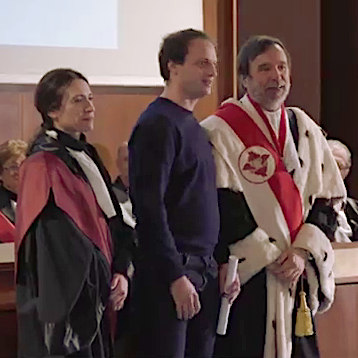 |
Lorenzo Francesco Livi has been awarded with a prize from Florence University Press for the best PhD thesis discussed in 2018 at University of Florence among all the scientific disciplines. The prize will consist in the publication of the thesis, titled "New quantum simulations with ultracold Ytterbium gases", by Florence University Press. The diploma has been given to Lorenzo by Prof. Luigi Dei, Rector of the University of Florence, in a public ceremony. Congratulations! Lorenzo Francesco Livi |
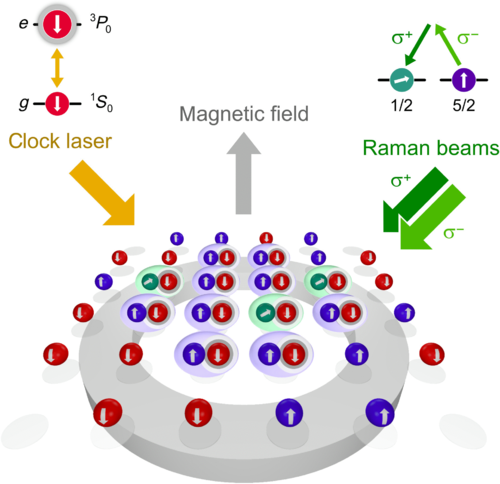 |
Ultracold molecules have experienced increasing attention in recent years. Compared to ultracold atoms, they possess several unique properties that make them perfect candidates for the implementation of new quantum-technological applications in several fields, from quantum simulation to quantum sensing and metrology. In particular, ultracold molecules of two-electron atoms (such as strontium or ytterbium) also inherit the peculiar properties of these atomic species, above all, the possibility to access metastable electronic states via direct excitation on optical clock transitions with ultimate sensitivity and accuracy. We report on the production and coherent manipulation of molecular bound states of two fermionic 173Yb atoms in different electronic (orbital) states 1S0 and eP0 in the proximity of a scattering resonance involving atoms in different spin and electronic states, called orbital Feshbach resonance. We demonstrate that orbital molecules can be coherently photoassociated starting from a gas of ground-state atoms in a three-dimensional optical lattice by observing several photoassociation and photodissociation cycles. We also show the possibility to coherently control the molecular internal state by using Raman-assisted transfer to swap the nuclear spin of one of the atoms forming the molecule, thus demonstrating a powerful manipulation and detection tool of these molecular bound states. Finally, by exploiting this peculiar detection technique we provide the first information on the lifetime of the molecular states in a many-body setting, paving the way towards future investigations of strongly interacting Fermi gases in a still unexplored regime. G. Cappellini, et al. |
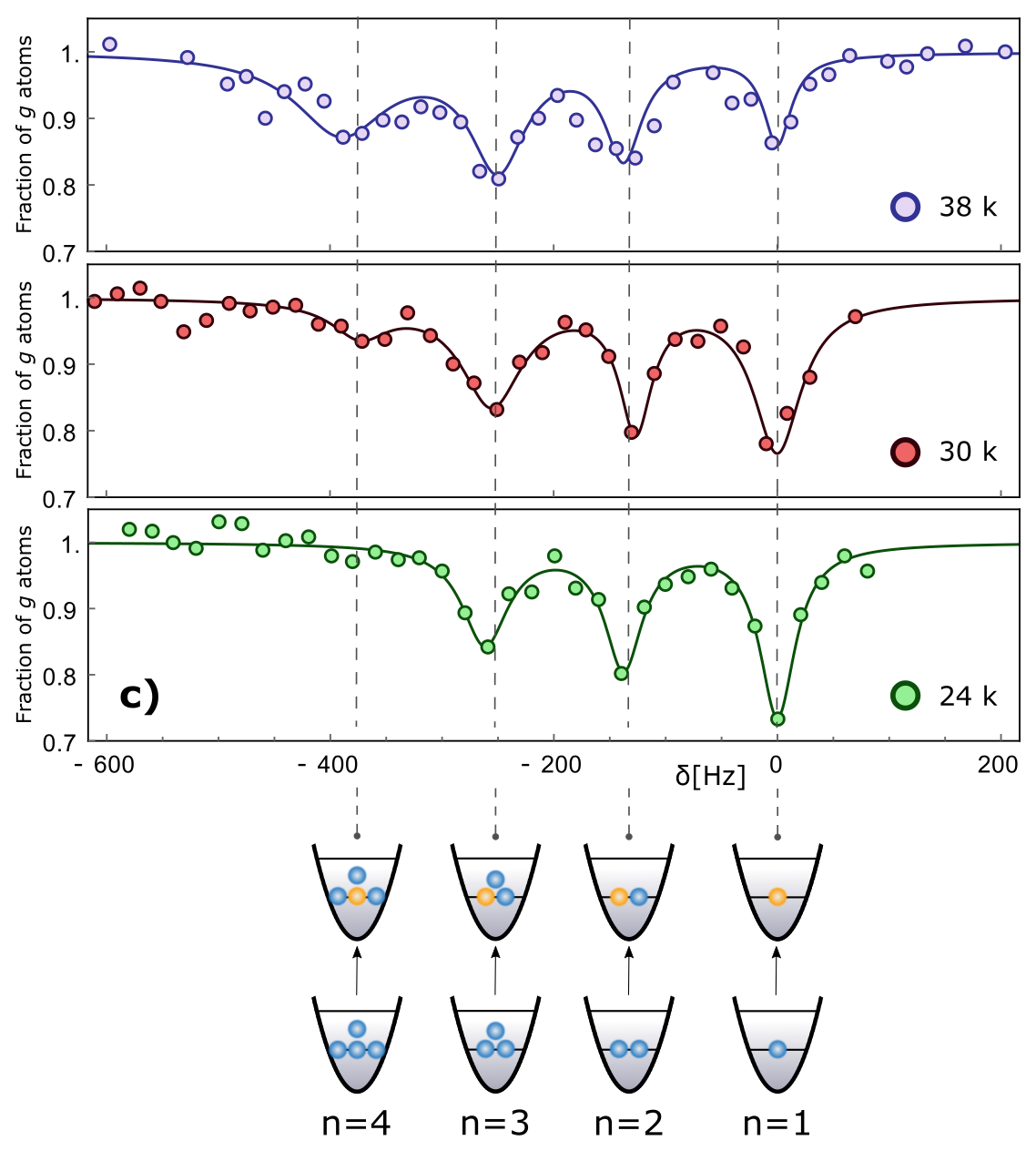 |
We report on the measurement of the scattering properties of ultracold 174Yb bosons in a three-dimensional optical lattice. Site occupancy in an atomic Mott insulator is resolved with high-precision spectroscopy on an ultranarrow, metrological optical clock transition. Scattering lengths and loss rate coefficients for 174Yb atoms in different collisional channels involving the ground state 1S0 and the metastable 3P0 states are derived. These studies set important constraints for future experimental studies of two-electron atoms for quantum-technological applications L. Franchi et al., |
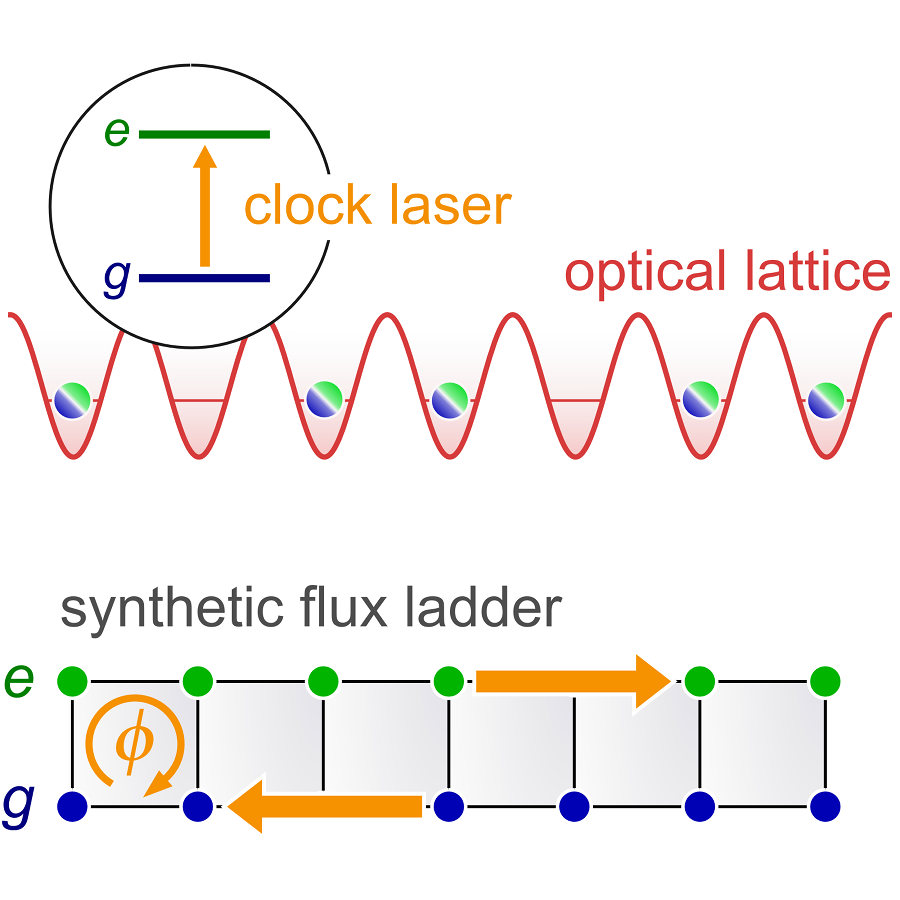 |
We demonstrate a novel way of synthesizing spin-orbit interactions in ultracold quantum gases, based on a single-photon optical clock transition coupling two long-lived electronic states of two-electron 173Yb atoms. By mapping the electronic states onto effective sites along a synthetic “electronic” dimension, we have engineered fermionic ladders with synthetic magnetic flux in an experimental configuration that has allowed us to achieve uniform fluxes on a lattice with minimal requirements and unprecedented tunability. We have detected the spin-orbit coupling with fiber-link-enhanced clock spectroscopy and directly measured the emergence of chiral edge currents, probing them as a function of the flux. These results open new directions for the investigation of topological states of matter with ultracold atomic gases. L. F. Livi et al., |
 |
Global Positioning System (GPS) dissemination of frequency standards is ubiquitous at present, providing the most widespread time and frequency reference for the majority of industrial and research applications worldwide. On the other hand, the ultimate limits of the GPS presently curb further advances in high-precision, scientific and industrial applications relying on this dissemination scheme. Here, we demonstrate that these limits can be reliably overcome even in laboratories without a local atomic clock by replacing the GPS with a 642-km-long optical fiber link to a remote primary caesium frequency standard. Through this configuration we stably address the 1S0 → 3P0 clock transition in an ultracold gas of 173Yb, with a precision that exceeds the possibilities of a GPS-based measurement, dismissing the need for a local clock infrastructure to perform beyond-GPS high-precision tasks. We also report an improvement of two orders of magnitude in the accuracy on the transition frequency reported in literature. C. Clivati et al., |
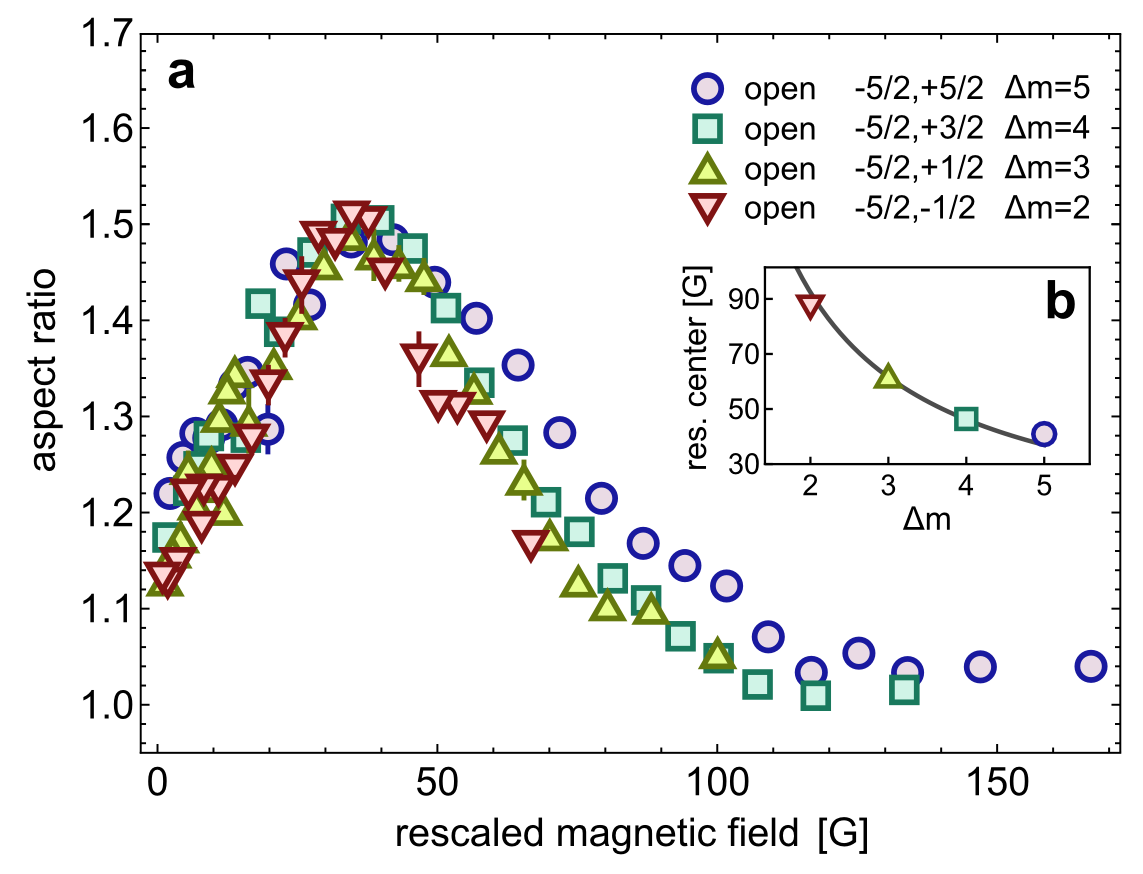 |
We report on the experimental observation of a strongly interacting gas of ultracold two-electron fermions with an orbital degree of freedom and magnetically tunable interactions. This realization has been enabled by the demonstration of a novel kind of Feshbach resonance occurring in the scattering of two 173Yb atoms in different nuclear and electronic states. The strongly interacting regime at resonance is evidenced by the observation of anisotropic hydrodynamic expansion of the two-orbital Fermi gas. These results pave the way towards the realization of new quantum states of matter with strongly correlated fermions with an orbital degree of freedom. G. Pagano et al., See also the Physics Viewpoint by S. Cornish: S. Cornish |
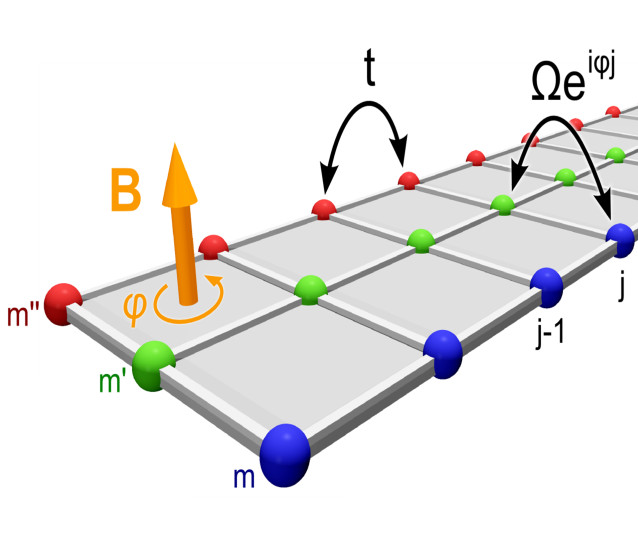 |
Chiral edge states are a hallmark of quantum Hall physics. In electronic systems, they appear as a macroscopic consequence of the cyclotron orbits induced by a magnetic field, which are naturally truncated at the physical boundary of the sample. Here we report on the experimental realization of chiral edge states in a ribbon geometry with an ultracold gas of neutral fermions subjected to an artificial gauge field. By imaging individual sites along a synthetic dimension, we detect the existence of the edge states, investigate the onset of chirality as a function of the bulk-edge coupling, and observe the edge-cyclotron orbits induced during a quench dynamics. The realization of fermionic chiral edge states is a fundamental achievement, which opens the door towards experiments including edge state interferometry and the study of non-Abelian anyons in atomic systems. M. Mancini et al., See also the Science Perspective by A. Celi and L. Tarruell: A. Celi and L. Tarruell |
 |
We report on the first direct observation of fast spin-exchange coherent oscillations between different long-lived electronic orbitals of ultracold 173Yb fermions. We measure, in a model-independent way, the strength of the exchange interaction driving this coherent process. This observation allows us to retrieve important information on the inter-orbital collisional properties of 173Yb atoms and paves the way to novel quantum simulations of paradigmatic models of two-orbital quantum magnetism. G. Cappellini et al., See also the Physics Viewpoint by A. M. Rey: A. M. Rey |
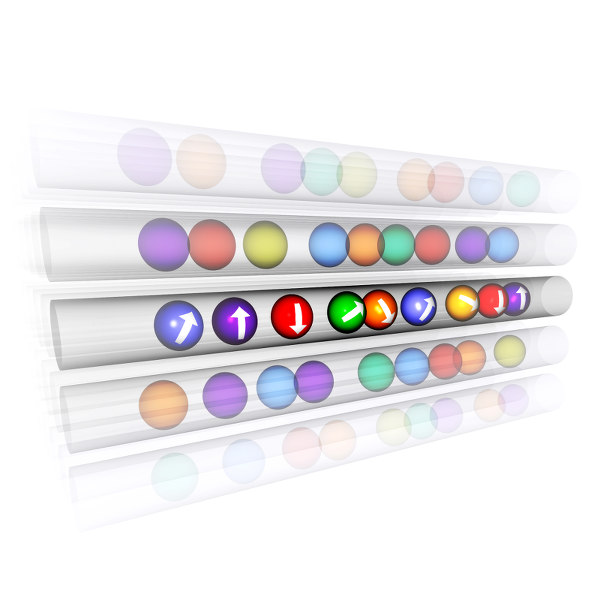 |
Correlations in systems with spin degree of freedom are at the heart of fundamental phenomena, ranging from magnetism to superconductivity. The effects of correlations depend strongly on dimensionality, a striking example being one-dimensional (1D) electronic systems, extensively studied theoretically over the past fifty years. However, the experimental investigation of the role of spin multiplicity in 1D fermions — and especially for more than two spin components — is still lacking. Here we report on the realization of 1D, strongly correlated liquids of ultracold fermions interacting repulsively within SU(N) symmetry, with a tunable number N of spin components. We observe that static and dynamic properties of the system deviate from those of ideal fermions and, for N > 2, from those of a spin-1/2 Luttinger liquid. In the large-N limit, the system exhibits properties of a bosonic spinless liquid. Our results provide a testing ground for many-body theories and may lead to the observation of fundamental 1D effects. G. Pagano et al., |



